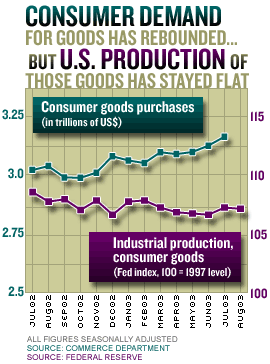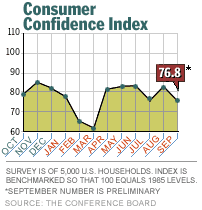NEW YORK (CNN/Money) -
When trying to call trends in the U.S. economy, it's always dangerous to give too much weight to individual indicators.
But the numbers so far this week seem to paint a picture of an economy that's not quite as awful as it's been, but not quite as strong as some forecasts have hoped.

"There are definitely winners and losers in this recovery," the Institute for Supply Management (ISM) said in releasing the results of its September survey of manufacturing activity.
The market's reaction to the ISM survey was telling -- though it fell short of Wall Street's official forecasts, it wasn't quite as awful as many traders thought it would be, based on a gloomy report on Chicago-area manufacturing from that region's purchasing managers on Tuesday.
And while the reading may have missed the "whisper number" among traders, the ISM report did show growth in manufacturing, and a separate report on the job market said the pace of layoffs slowed markedly in September.
Still, consumer confidence numbers reported Tuesday fell, hurt by a weak job market, and Wednesday's ISM report showed layoffs in the manufacturing sector seem actually to be accelerating.
"Broadly, [the ISM number] reflects what we've been saying for some time: We're on the road to recovery, and we've seen the slowest growth behind us -- but this recovery is going to proceed in fits and starts. It's not going to be a one-way street," said former Federal Reserve economist Lara Rhame, now a senior economist with Brown Brothers Harriman.
| Related stories
|

|
|
|
|
On the plus side, consumer spending boomed in the third quarter, helped along by tax credit checks and cash from mortgage refinancings, manufacturing activity has been growing for a few months in a row, and corporate credit conditions have improved, setting the stage for a pickup in business spending.
But on the other side is the 800-pound gorilla -- the job market. Employers have cut 2.8 million since the last recession started in March 2001, and nearly 2 million people have been out of work for more than 27 weeks. The Labor Department is expected to report that 25,000 more jobs were lost in September, according to analysts surveyed by Briefing.com.
Though many economists hope stronger economic growth will lead to renewed hiring soon, very few think there will be enough job growth to fulfill the promise of President Bush's Council of Economic Advisers that this year's tax cuts will create 510,000 jobs by the end of the year.

"The manufacturing data certainly are positive, but the employment data specifically reinforce the notion that domestic growth is not going be enough to create many jobs," Rhame said.
Belying the optimism expressed in the headline ISM reading -- which is the result of a survey of businesses -- the stronger economic growth also hasn't done much to improve the hard data on industrial production.
Despite a jump in consumer spending on goods late in the summer, domestic production of goods, as reported by the Fed, has stayed flat, according to recent research by Robert Brusca, chief economist of Native American Securities in New York.
"While consumer spending has sparked up a bit recently, linking it to better output growth is still highly speculative," Brusca said.
Though, at first blush, it would seem that demand for consumer goods should be satisfied by imports, the Commerce Department's data on consumer-goods imports has been as flat as the industrial production data -- July's level of imports was actually lower than in March.
Though some consumer demand likely was met by pulling goods from inventories, companies aren't working to rebuild those inventories, according to Wednesday's ISM report, indicating businesses may not be confident that demand will keep rising enough to force them to rebuild inventories.
"Less inventory suggests a cap on the bounceback in the economy, as less production of inventories domestically means less production, labor demand and growth," Wachovia Securities chief economist John Silvia said.
Some economists warn that, taken together, the numbers indicate the economy still is in some danger of slowing down again -- especially if job growth and wages don't pick up soon, as the stimulative effects of tax-credit checks and refi cash fade.
"A self-sustaining recovery depends on job growth," said Gerald Cohen, senior economist at Merrill Lynch. "And I think we will get some going forward."

|

